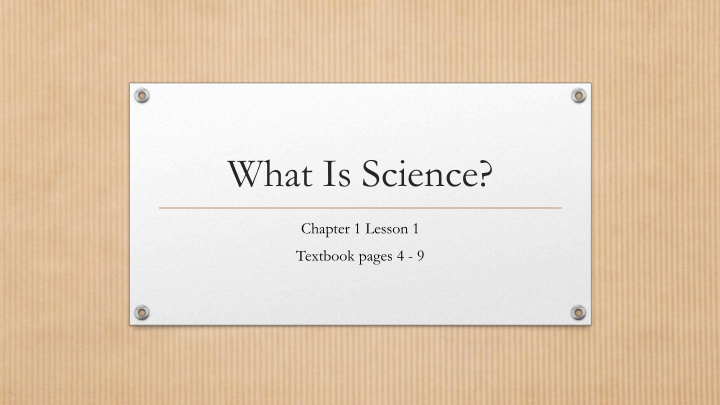



What Is Science? Chapter 1 Lesson 1 Textbook pages 4 - 9
What Science Is and Is Not • Science is not a collection of unchanging beliefs about the world. • Scientific ideas are open to testing, discussion, and revision. Science is subject to change. • What is science?
Science as a Way of Knowing • Science: an organized way of gathering and analyzing evidence about the natural world. • Science is a process, not a thing. • Science deals only with the natural world. • Scientists collect and organize information in an orderly way, looking for patterns and connections. • Scientists propose explanations based on evidence, not beliefs.
The Goals of Science • One goal of science is to provide natural explanations for events in the natural world.
Myth Busted! • Aristotle (384-322 BC) believed the Earth was spherical – He believed this because of the shadow that was cast on the moon during a lunar eclipse. • Christopher Columbus believed the Earth was round and set sail to find the East Indies, but instead found the Americas in the 1400s. • Ferdinand Magellan was the first person to circumnavigate the Earth in the 1500’s, concluding that the Earth was indeed a • sphere. Flat Earth map drawn by Orlando Ferguson in 1893. • Many ancient cultures believed in a “Flat Earth” and that http://scienceblogs.com/startswithabang/2011/09/21/who-discovered- the-earth-is-ro/ when you traveled to the end of it, you fell off
The Goals of Science • Science also aims to use those explanations to understand patterns in nature and to make useful predictions about natural events.
Science, Change, and Uncertainty • Over the centuries, scientists have gathered an enormous amount of data about the natural world. • Because science never stands still, almost every major discovery leads to new questions. • This constant change and uncertainty allows science to advance and mysteries to be solved. • Uncertainty is exciting!
Science Methodology: The Heart of Science • Scientists are problem solvers. • There isn’t a single method for solving problems, there is a general style of investigation called scientific methodology. This process involves: • Observing and asking questions. • Making inferences and forming hypotheses. • Designing Experiments • Conducting experiments. • Collecting and analyzing data. • Drawing conclusions.
Observing and Asking Questions • Scientific investigations begin with observation. • Observation is the act of noticing and describing events or processes in a careful, orderly way. • Quantitative Observations have to do with “quantities” or numbers, amounts, measurements, etc. • Qualitative Observations have to do with “qualities” or observations made with the senses such as texture, color, odor, etc.
Inferring and Forming a Hypothesis • An inference is a logical interpretation based on what scientists already know. • Inference, in combination with imagination, can lead to a hypothesis. • A hypothesis is a scientific explanation for a set of observations that can be tested in a way that it can be supported or rejected. QUESTION: What will happen if I drop a tennis ball from waist high? What about from shoulder high?
Designing Controlled Experiments • In a controlled experiment, only one variable is changed while all other variables stay the same. • It is important to control variables so you know what is producing the change in the experiment. • It is also important to have a control group in an experiment. The control group is exposed to the same conditions as the experimental groups except for the changed variable.
DRY MIX Variables • D: Dependent Variable • R: Responding Variable (the variable that changes in response to the IV) • Y: Graphed on the Y – Axis • M: Manipulated Variable (the variable deliberately changed) • I: Independent Variable • X: Graphed on the X - Axis
Dependent v. Independent Variables • The dependent variable is 'dependent' on the independent variable. As the experimenter changes the independent variable, the effect on the dependent variable is observed and recorded.
DRY MIX Variable Examples
DRY MIX Variable Examples
DRY MIX Variable Examples
DRY MIX Variable Examples
Collecting and Analyzing Data • Data collected can be either quantitative or qualitative (like observations). • Research tools include calculators, computers, probes, charts, graphs, notebooks, journals, etc. • Researchers must be careful to avoid errors in data collection and analysis. • The larger the sample size, the more reliable the results of an experiment. • Accuracy and precision are important in scientific investigations.
Drawing Conclusions • Scientists use experimental data to support, refute, or revise a hypothesis. • Hypotheses are often not fully supported or refuted based on one experiment. Instead the data tells scientists if they are on the right track or not. • Often hypotheses are reevaluated and revised. A new experiment is then conducted and more data collected.
When Experiments Are Not Possible • When experiments are not possible, scientists can test hypotheses through observations. • Animal behavior researchers observe animals in the wild. • Sometimes ethics prevents certain types of experimentation. • Ex: Cancer researchers could not intentionally expose humans to a type of chemical that may or may not cause cancer. They can ask for volunteers who have already been exposed to be the experimental group and use those not exposed as the control group.
Recommend
More recommend